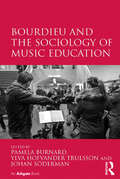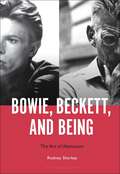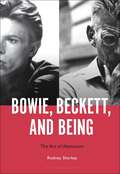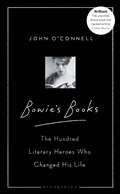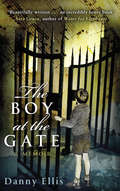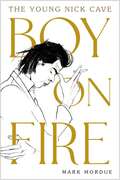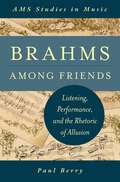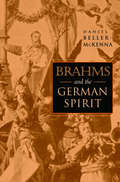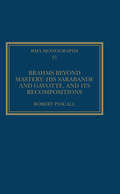- Table View
- List View
Bourdieu and the Sociology of Music Education
by Pamela Burnard Ylva Hofvander TrulssonPierre Bourdieu has been an extraordinarily influential figure in the sociology of music. For over four decades, his concepts have helped to generate both empirical and theoretical interventions in the field of musical study. His impact on the sociology of music taste, in particular, has been profound, his ideas directly informing our understandings of how musical preferences reflect and reproduce inequalities between social classes, ethnic groups, and men and women. Bourdieu and the Sociology of Music Education draws together a group of international researchers, academics and artist-practitioners who offer a critical introduction and exploration of Pierre Bourdieu’s rich generative conceptual tools for advancing sociological views of music education. By employing perspectives from Bourdieu’s work on distinction and judgement and his conceptualisation of fields, habitus and capitals in relation to music education, contributing authors explore the ways in which Bourdieu’s work can be applied to music education as a means of linking school (institutional habitus) and learning, and curriculum and family (class habitus). The volume includes research perspectives and studies of how Bourdieu’s tools have been applied in industry and educational contexts, including the primary, secondary and higher music education sectors. The volume begins with an introduction to Bourdieu’s contribution to theory and methodology and then goes on to deal in detail with illustrative substantive studies. The concluding chapter is an extended essay that reflects on, and critiques, the application of Bourdieu’s work and examines the ways in which the studies contained in the volume advance understanding. The book contributes new perspectives to our understanding of Bourdieu’s tools across diverse settings and practices of music education.
Bowie at the BBC: A life in interviews
by David Bowie Tom HaglerThe life of an icon, in his own words.David Bowie had a unique relationship with the BBC, making more appearances on 'the beeb' than any other broadcaster throughout his career. An anonymous pre-fame teenager, a blossoming starlet, a white-hot rock star and a veritable elder statesman of pop: the BBC had the inside scoop on it all.In this fascinating collection of BBC television and radio transcripts, Bowie's life story is told in his own words, across more than 35 appearances spanning over forty years. Each provides an illuminating snapshot of moments in a remarkable career. But read together, they offer a completely new take on Bowie himself, a first-person look at the rise and rise of a star.Compiled and guided by David Bowie expert and BBC journalist Tom Hagler, Bowie at the BBC is the complete story of an incredible life lived on the airwaves.
Bowie, Beckett, and Being: The Art of Alienation
by Professor Rodney SharkeyAddressing their shared passion for literature, art, and music, this book documents how Samuel Beckett and David Bowie produce extraordinarily empathetic creative outputs that reflect the experience and the effect of alienation. Through an exploration of their artistic practices, the study also illustrates how both artists articulate shared forms of human experience otherwise silenced by normative modes of representation. To liberate these experiences, Bowie and Beckett create alternative theatrical, musical, and philosophical spaces, which help frame the power relations of the psychological, verbal, and material places we inhabit. The result is that their work demonstrates how individuals are disciplined by the implicitly repressive social order of late capitalism, while, simultaneously, offering an informed political alternative. In making the injunctions of the social order apparent, Beckett and Bowie also transgress its terms, opening up new spaces beyond the conventional identities of family, nation, and gender, until both artists finally coalesce in the quantum space of the posthuman.
Bowie, Beckett, and Being: The Art of Alienation
by Professor Rodney SharkeyAddressing their shared passion for literature, art, and music, this book documents how Samuel Beckett and David Bowie produce extraordinarily empathetic creative outputs that reflect the experience and the effect of alienation. Through an exploration of their artistic practices, the study also illustrates how both artists articulate shared forms of human experience otherwise silenced by normative modes of representation. To liberate these experiences, Bowie and Beckett create alternative theatrical, musical, and philosophical spaces, which help frame the power relations of the psychological, verbal, and material places we inhabit. The result is that their work demonstrates how individuals are disciplined by the implicitly repressive social order of late capitalism, while, simultaneously, offering an informed political alternative. In making the injunctions of the social order apparent, Beckett and Bowie also transgress its terms, opening up new spaces beyond the conventional identities of family, nation, and gender, until both artists finally coalesce in the quantum space of the posthuman.
Bowie by O'Neill: The definitive collection with unseen images
by Terry O'NeillThis book is the breathtaking result of iconic photographer Terry O'Neill's creative partnership with David Bowie that spanned over a number of years, including images published here for the first time.Containing rare and never-before-seen photographs, their work together includes images from the last Ziggy Stardust performance, recording sessions for Young Americans and the renowned studio portraits for Diamond Dogs - plus live shows, film shoots, backstage moments and more. With more than 500 photographs, this is the ultimate portrait of an inspiring, challenging and ever-changing artist.
Bowie, Cambo & All the Hype
by John CambridgeIn Bowie, Cambo & All the Hype we get a backstage pass to key people and events during those crucial early years. This is a heartfelt story of a unique friendship.Drummer, musician and friend John ‘Cambo’ Cambridge lived with Bowie at Haddon Hall when he had his first hit record ‘Space Oddity’ and toured with him in Junior’s Eyes. He was there for him at many key moments – when Bowie lost his father, passed his driving test, played his first Glam Rock gig with Hype, even acting as best man when Bowie married Angela Barnett in 1970. And if John had not persuaded his former Rats colleague Mick Ronson to join Bowie in February 1970, there might never have been a Ziggy Stardust or the stellar career which followed.
Bowie's Books: The Hundred Literary Heroes Who Changed His Life
by John O'Connell'Brilliant. The unwritten Bowie book that needed writing' CAITLIN MORAN'What is your idea of perfect happiness?' 'Reading.''What is the quality you most like in a man?''The ability to return books.'Three years before he died, David Bowie made a list of the one hundred books that had transformed his life – a list that formed something akin to an autobiography. From Madame Bovary to A Clockwork Orange, the Iliad to the Beano, these were the publications that had fuelled his creativity and shaped who he was. In Bowie's Books, John O'Connell explores this list in the form of one hundred short essays, each offering a perspective on the man, performer and creator that is Bowie, his work as an artist and the era that he lived in.Bowie's Books is much more than a list of books you should read in your lifetime: it is a unique insight into one of the greatest minds of our times, and an indispensable part of the legacy that Bowie left behind.
Bowie's Books: The Hundred Literary Heroes Who Changed His Life
by John O'ConnellA TIMES BOOK OF THE YEAR'Brilliant. The unwritten Bowie book that needed writing' CAITLIN MORAN'Splendid. Provides plenty of evidence of Bowie's restless, rummaging intelligence, and his pleasure in the fact that books allow readers to slip into someone else's skin and try it on for size' THE TIMES'A witty and enlightening analysis of Bowie's 100 essential books . . . A handy, amusing, light-touch precis' OBSERVER'What is your idea of perfect happiness?' 'Reading.''What is the quality you most like in a man?''The ability to return books.'Three years before he died, David Bowie made a list of the one hundred books that had transformed his life – a list that formed something akin to an autobiography. From Madame Bovary to A Clockwork Orange, the Iliad to the Beano, these were the publications that had fuelled his creativity and shaped who he was. In Bowie's Books, John O'Connell explores this list in the form of one hundred short essays, each offering a perspective on the man, performer and creator that is Bowie, his work as an artist and the era that he lived in.Brilliantly illustrated throughout and the perfect gift for Bowie fans and book lovers, Bowie's Books is much more than a list of books you should read in your lifetime: it is a unique insight into one of the greatest minds of our times, and an indispensable part of the legacy that Bowie left behind.
Boy About Town
by Tony Fletcher'I was no longer fitting in at school. I was unsure of my friends, and they were increasingly unsure of me. I wanted to be a rock star. But while all around, voices were starting to break, acne beginning to appear, facial hair sprouting, I remained all flabby flesh and innate scruff, with a high-pitched whine and not a muscle to my name. I was the runt of the class and rarely allowed to forget it. I had no father at home to help me out, and could hardly talk to my mum. So I took solace in The Jam.'As a boy, Tony Fletcher frequently felt out of place. Yet somehow he secured a ringside seat for one of the most creative periods in British cultural history. Boy About Town tells the story of the bestselling author’s formative years in the pre- and post-punk music scenes of London, counting down, from fifty to number one: attendance at seminal gigs and encounters with musical heroes; schoolboy projects that became national success stories; the style culture of punks, mods and skinheads and the tribal violence that enveloped them; life as a latchkey kid in a single-parent household; weekends on the football terraces in a quest for street credibility; and the teenage boy’s unending obsession with losing his virginity.Boy About Town is an evocative, bittersweet, amusing and wholly original account of growing up and coming of age in the glory days of the 1970s.
The Boy at the Gate: A Memoir
by Danny EllisDanny Ellis was a survivor, strong and resilient. A successful singer/songwriter, he was proud of the way he’d ‘handled’ his painful past: the grinding poverty of the 1950s Dublin slums, and the brutality of the orphanage, the notorious Artane Industrial School where he was left. He’d safely buried it. Or so he thought.Then one night, while writing a powerful song that would launch his acclaimed album, 800 Voices, his past came flooding back to haunt him. Long-forgotten memories of betrayal and abandonment burst forth in a shocking revelation: his eight-year-old self was still lost in the orphanage.Although badly shaken, Danny began a courageous journey that would lead him back to the streets of Dublin, to the tenement slums and, eventually, to the brutality and scallywag shenanigans of the Artane playground. What he found with each twist and turn of his odyssey would change his life for ever.The Boy at the Gate is a poignant, profoundly moving memoir of forgiveness and redemption, and an inspiring testament to the healing power of music and love.
Boy Bands and the Performance of Pop Masculinity
by Georgina GregoryBoy Bands and the Performance of Pop Masculinity provides a history of the boy band from the Beatles to One Direction, placing the modern male pop group within the wider context of twentieth- and twenty-first-century popular music and culture. Offering the first extended look at pop masculinity as exhibited by boy bands, this volume links the evolving expressions of gender and sexuality in the boy band to wider economic and social changes that have resulted in new ways of representing what it is to be a man. The popularity of boy bands is unquestionable, and their contributions to popular music are significant, yet they have attracted relatively little study. This book fills that gap with chapters exploring the challenges of defining the boy band phenomenon, its origins and history from the 1940s to the present, the role of management and marketing, the performance of gender and sexuality, and the nature of fandom and fan agency. Throughout, the author illuminates the ways in which identity politics influence the production and consumption of pop music and shows how the mainstream pop of boy bands can both reinforce and subvert gender and class hierarchies.
Boy Bands and the Performance of Pop Masculinity
by Georgina GregoryBoy Bands and the Performance of Pop Masculinity provides a history of the boy band from the Beatles to One Direction, placing the modern male pop group within the wider context of twentieth- and twenty-first-century popular music and culture. Offering the first extended look at pop masculinity as exhibited by boy bands, this volume links the evolving expressions of gender and sexuality in the boy band to wider economic and social changes that have resulted in new ways of representing what it is to be a man. The popularity of boy bands is unquestionable, and their contributions to popular music are significant, yet they have attracted relatively little study. This book fills that gap with chapters exploring the challenges of defining the boy band phenomenon, its origins and history from the 1940s to the present, the role of management and marketing, the performance of gender and sexuality, and the nature of fandom and fan agency. Throughout, the author illuminates the ways in which identity politics influence the production and consumption of pop music and shows how the mainstream pop of boy bands can both reinforce and subvert gender and class hierarchies.
The Boy in the Song: The Real Stories Behind 50 Classic Pop Songs
by Michael HeatleyThe Boy in the Song is a follow up to 2010's The Girl in the Song. It features the real-life stories that inspired some classic pop songs about the male of the species. While the first book was filled with songs about unrequited love, the follow-up is more varied, with songs written from a number of emotions. There are songs motivated by love and hate, there are tributes and there are biographical tales. Each song is featured on two, four or six pages with a small biography of the artist along with the story of how and why the song was written, and, most intriguingly, what happened after the song became a hit.
Boy on Fire: The Young Nick Cave
by Mark MordueAn intensely beautiful, profound and poetic biography of the formative years of the dark prince of rock 'n' roll, Boy on Fire is Nick Cave's creation story, a portrait of the artist first as a boy, then as a young man. A deeply insightful work which charts his family, friends, influences, milieu and, most of all, his music, it reveals how Nick Cave shaped himself into the extraordinary artist he would become.A powerful account of a singular, uncompromising artist, Boy on Fire is also a vivid and evocative rendering of a time and place, from the fast-running dark rivers and ghost gums of country-town Australia to the torn wallpaper, sticky carpet and manic energy of the nascent punk scene which hit staid 1970s Melbourne like an atom bomb. Boy on Fire is a stunning biographical achievement.
Boys in the Trees: A Memoir
by Carly Simon#1 New York Times BestsellerA People Magazine Top Ten Book of the Year'A sensational memoir . . . brilliantly well written. Carly Simon is incapable of writing a boring sentence . . . you can forgive anything for the unparalleled brilliance of her writing' - Lynn Barber, Sunday Times'Hugely affecting memoir . . . heartfelt and remarkable' - Fiona Sturges, IndependentCarly Simon is a household name. She was the staple of the '70s and '80s Billboard charts and was famously married to James Taylor with whom she has two children. She has had a career that has spanned four decades, resulting in thirteen top 40 hits, including the Number 1 song 'You're So Vain', numerous Grammy Awards, a Golden Globe and an Academy Award. She was the first artist in history to win a Grammy Award, an Academy Award and a Golden Globe Award for her song 'Let the River Run' (from the film Working Girl). Boys in the Trees is a rhapsodic, beautifully composed memoir of a young woman's coming of age amongst the glamorous literati and intelligentsia of Manhattan (her father was Richard Simon, co-founder of publishing giant Simon & Schuster), a reflection on a life begun amidst secrets and shame, and a powerful story of the strength to leave that all behind and forge a path of art, music and love in the Golden Age of folk and rock.At once an insider's look into a life in the spotlight, a lyric reflection on a particular time in our culture's history, and a beautiful memoir about the pains and joys of love and art, Boys in the Trees is the story Carly Simon has long been waiting to tell the world.Praise for the US edition:'One of the best celebrity memoirs of the year' Hollywood Reporter'Intelligent and captivating' People'Compelling' Rolling Stone
Brahms: The Great Composers (The Great Composers)
by Michael SteenWelcome to The Independent’s new ebook series The Great Composers, covering fourteen of the giants of Western classical music. Extracted from Michael Steen’s book The Lives and Times of the Great Composers, these concise guides, selected by The Independent’s editorial team, explore the lives of composers as diverse as Mozart and Puccini, reaching from Bach to Brahms, set against the social, historical and political forces which affected them, to give a rounded portrait of what it was like to be alive and working as a musician at that time. It was Schumann who first hailed Brahms as ‘the natural heir and successor to Beethoven’, and that is how many have seen him since, although to Brahms himself it was something of a burden. With his devotion to classical precepts, he proved himself a master of all the major forms bar one. His four symphonies, his concertos, his vast body of chamber music, where discipline underpins the wonderful romantic harmonies, remain central to the repertoire. During his own life, it was the rapturous reception of his German Requiem which established him beyond all doubt. The only form he never attempted was opera, which would have been ill-suited to his virtues as a composer. Michael Steen shows how Brahms came to be raised up as the champion of traditional values against the new music of composers such as Liszt and Wagner, in one of the most bitterly fought controversies of the age. On tour as a young man from Hamburg, Brahms met the violin virtuoso Joachim, who introduced him to Schumann. During Schumann's period of insanity and especially after his death, Brahms developed a lifelong friendship with his widow, Clara. Steen chronicles his autumns teaching in Detmold, his passing loves, and eventual move to Vienna, where he would spend his winters, escaping to a variety of resorts to compose over the summer. He died at 63, still a bachelor.
Brahms Among Friends: Listening, Performance, and the Rhetoric of Allusion (AMS Studies in Music)
by Paul BerryBrahms Among Friends identifies patterns of listening, performance, and composition among close friends of Johannes Brahms and explores how those patterns informed the creation and reception of his music in the intimate genres of song, sonata, trio, and piano miniature. Among the tangled threads of counterpoint and circumstance that bound Brahms to his acquaintances was the technique of allusive musical borrowing, whereby a brief passage from a familiar work was drawn into the fabric of a new composition. For the specific listeners whose habits of mind and musicianship he knew best, allusive borrowings could become rhetorically charged gestures, persuasively revising the meanings his music conveyed and the interpretive strategies it invited. Primary documents, original manuscripts, music-analytic comparison, and kinesthetic parameters experienced in the act of performance all work in tandem to support ten case studies in the interplay between Brahms's small-scale works and the women and men who encountered them before publication. Central characters include violinist Joseph Joachim, singers Amalie Joachim, Julius Stockhausen, and Agathe von Siebold, composers Heinrich and Elisabeth von Herzogenberg, and pianists Emma Engelmann and Clara Schumann. For these musicians and for the composer himself, Brahms's allusive music served a broad variety of emotional needs and interpersonal ends. Yet across diverse repertoire and interdisciplinary correlates ranging from ethnography to psychoanalysis, each case study furthers a single, underlying aim: to reconstruct the mutually dependent perspectives of historically situated agents and restore forgotten features of their communicative landscapes as bases for both musical and historical scrutiny.
Brahms and His World: (Revised Edition)
by Walter Frisch Kevin C. KarnesSince its first publication in 1990, Brahms and His World has become a key text for listeners, performers, and scholars interested in the life, work, and times of one of the nineteenth century's most celebrated composers. In this substantially revised and enlarged edition, the editors remain close to the vision behind the original book while updating its contents to reflect new perspectives on Brahms that have developed over the past two decades. To this end, the original essays by leading experts are retained and revised, and supplemented by contributions from a new generation of Brahms scholars. Together, they consider such topics as Brahms's relationship with Clara and Robert Schumann, his musical interactions with the "New German School" of Wagner and Liszt, his influence upon Arnold Schoenberg and other young composers, his approach to performing his own music, and his productive interactions with visual artists. The essays are complemented by a new selection of criticism and analyses of Brahms's works published by the composer's contemporaries, documenting the ways in which Brahms's music was understood by nineteenth- and early twentieth-century audiences in Europe and North America. A new selection of memoirs by Brahms's friends, students, and early admirers provides intimate glimpses into the composer's working methods and personality. And a catalog of the music, literature, and visual arts dedicated to Brahms documents the breadth of influence exerted by the composer upon his contemporaries.
Brahms and His World: (Revised Edition) (PDF)
by Walter Frisch Kevin C. KarnesSince its first publication in 1990, Brahms and His World has become a key text for listeners, performers, and scholars interested in the life, work, and times of one of the nineteenth century's most celebrated composers. In this substantially revised and enlarged edition, the editors remain close to the vision behind the original book while updating its contents to reflect new perspectives on Brahms that have developed over the past two decades. To this end, the original essays by leading experts are retained and revised, and supplemented by contributions from a new generation of Brahms scholars. Together, they consider such topics as Brahms's relationship with Clara and Robert Schumann, his musical interactions with the "New German School" of Wagner and Liszt, his influence upon Arnold Schoenberg and other young composers, his approach to performing his own music, and his productive interactions with visual artists. The essays are complemented by a new selection of criticism and analyses of Brahms's works published by the composer's contemporaries, documenting the ways in which Brahms's music was understood by nineteenth- and early twentieth-century audiences in Europe and North America. A new selection of memoirs by Brahms's friends, students, and early admirers provides intimate glimpses into the composer's working methods and personality. And a catalog of the music, literature, and visual arts dedicated to Brahms documents the breadth of influence exerted by the composer upon his contemporaries.
Brahms and the German Spirit
by Daniel. Beller-McKennaThe music of Johannes Brahms is deeply colored, Daniel Beller-McKenna shows, by nineteenth-century German nationalism and by Lutheran religion. Focusing on the composer's choral works, the author offers new insight on the cultural grounding for Brahms's music. Music historians have been reluctant to address Brahms's Germanness, wary perhaps of fascist implications. Beller-McKenna counters this tendency; by giving an account of the intertwining of nationalism, politics, and religion that underlies major works, he restores Brahms to his place in nineteenth-century German culture. The author explores Brahms's interest in the folk element in old church music; the intense national pride expressed in works such as the Triumphlied; the ways Luther's Bible and Lutheranism are reflected in Brahms's music; and the composer's ideas about nation building. The final chapter looks at Brahms's nationalistic image as employed by the National Socialists, 1933-1945, and as witnessed earlier in the century (including the complication of rumors that Brahms was Jewish). In comparison to the overtly nationalist element in Wagner's music, the German elements in Brahms's style have been easy to overlook. This nuanced study uncovers those nationalistic elements, enriching our understanding both of Brahms's art and of German culture.
Brahms and the German Spirit (PDF)
by Daniel Beller-McKennaThe music of Johannes Brahms is deeply colored, Daniel Beller-McKenna shows, by nineteenth-century German nationalism and by Lutheran religion. Focusing on the composer's choral works, the author offers new insight on the cultural grounding for Brahms's music. Music historians have been reluctant to address Brahms's Germanness, wary perhaps of fascist implications. Beller-McKenna counters this tendency; by giving an account of the intertwining of nationalism, politics, and religion that underlies major works, he restores Brahms to his place in nineteenth-century German culture. The author explores Brahms's interest in the folk element in old church music; the intense national pride expressed in works such as the Triumphlied; the ways Luther's Bible and Lutheranism are reflected in Brahms's music; and the composer's ideas about nation building. The final chapter looks at Brahms's nationalistic image as employed by the National Socialists, 1933-1945, and as witnessed earlier in the century (including the complication of rumors that Brahms was Jewish). In comparison to the overtly nationalist element in Wagner's music, the German elements in Brahms's style have been easy to overlook. This nuanced study uncovers those nationalistic elements, enriching our understanding both of Brahms's art and of German culture.
Brahms and the Scherzo: Studies in Musical Narrative
by Ryan McClellandDespite the incredible diversity in Brahms's scherzo-type movements, there has been no comprehensive consideration of this aspect of his oeuvre. Professor Ryan McClelland provides an in-depth study of these movements that also contributes significantly to an understanding of Brahms's compositional language and his creative dialogue with musical traditions. McClelland especially highlights the role of rhythmic-metric design in Brahms's music and its relationship to expressive meaning. In Brahms's scherzo-type movements, McClelland traces transformations of primary thematic material, demonstrating how the relationship of the initial music to its subsequent versions creates a musical narrative that provides structural coherence and generates expressive meaning. McClelland's interpretations of the expressive implications of Brahms's fascinatingly intricate musical structures frequently engage issues directly relevant to performance. This illuminating book will appeal to music theorists, musicologists working on nineteenth-century instrumental music and performers.
Brahms and the Scherzo: Studies in Musical Narrative
by Ryan McClellandDespite the incredible diversity in Brahms's scherzo-type movements, there has been no comprehensive consideration of this aspect of his oeuvre. Professor Ryan McClelland provides an in-depth study of these movements that also contributes significantly to an understanding of Brahms's compositional language and his creative dialogue with musical traditions. McClelland especially highlights the role of rhythmic-metric design in Brahms's music and its relationship to expressive meaning. In Brahms's scherzo-type movements, McClelland traces transformations of primary thematic material, demonstrating how the relationship of the initial music to its subsequent versions creates a musical narrative that provides structural coherence and generates expressive meaning. McClelland's interpretations of the expressive implications of Brahms's fascinatingly intricate musical structures frequently engage issues directly relevant to performance. This illuminating book will appeal to music theorists, musicologists working on nineteenth-century instrumental music and performers.
Brahms Beyond Mastery: His Sarabande and Gavotte, and its Recompositions
by Robert PascallIn 1853 Robert Schumann identified fully-formed compositional mastery in the young Brahms, who nevertheless in the years following embarked on a period of intensive further study, producing, among other works, the neo-baroque Sarabande and Gavotte. These dances have not been properly recognized as constituting a distinct Brahms work before now, but manuscript evidence and their performance history indicate that Brahms and his friends thought of them as such in the mid-1850s, when they became the first music of his performed publicly in Gdansk, Vienna, Budapest and London. He later suppressed the dances, using them instead as a thematic quarry for three chamber music masterpieces, from different stages in his life and in distinctly different ways: the Second String Sextet, the First String Quintet and the Clarinet Quintet. This book gives an account of the compositional and performance history, stylistic features and re-uses of the dances, setting these in the wider context of Brahms‘s developing creative concerns and trajectory. It constitutes therefore a study of alost work, of how a fully-formed master opens himself tothe in-flowing from afar (in Martin Heidegger‘s terms), and of the transformative reach and concomitant expressive richness of Brahms‘s creative thought.
